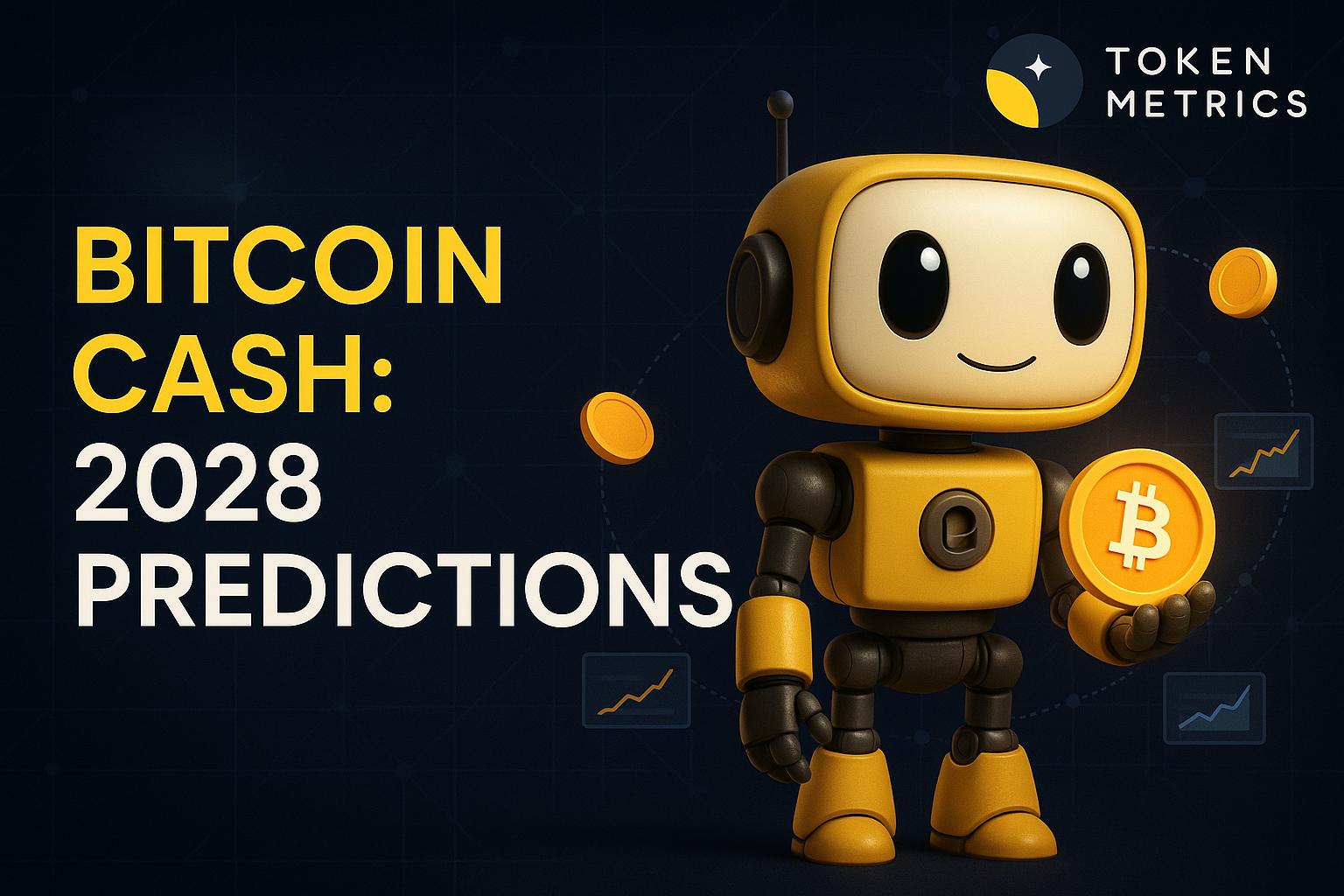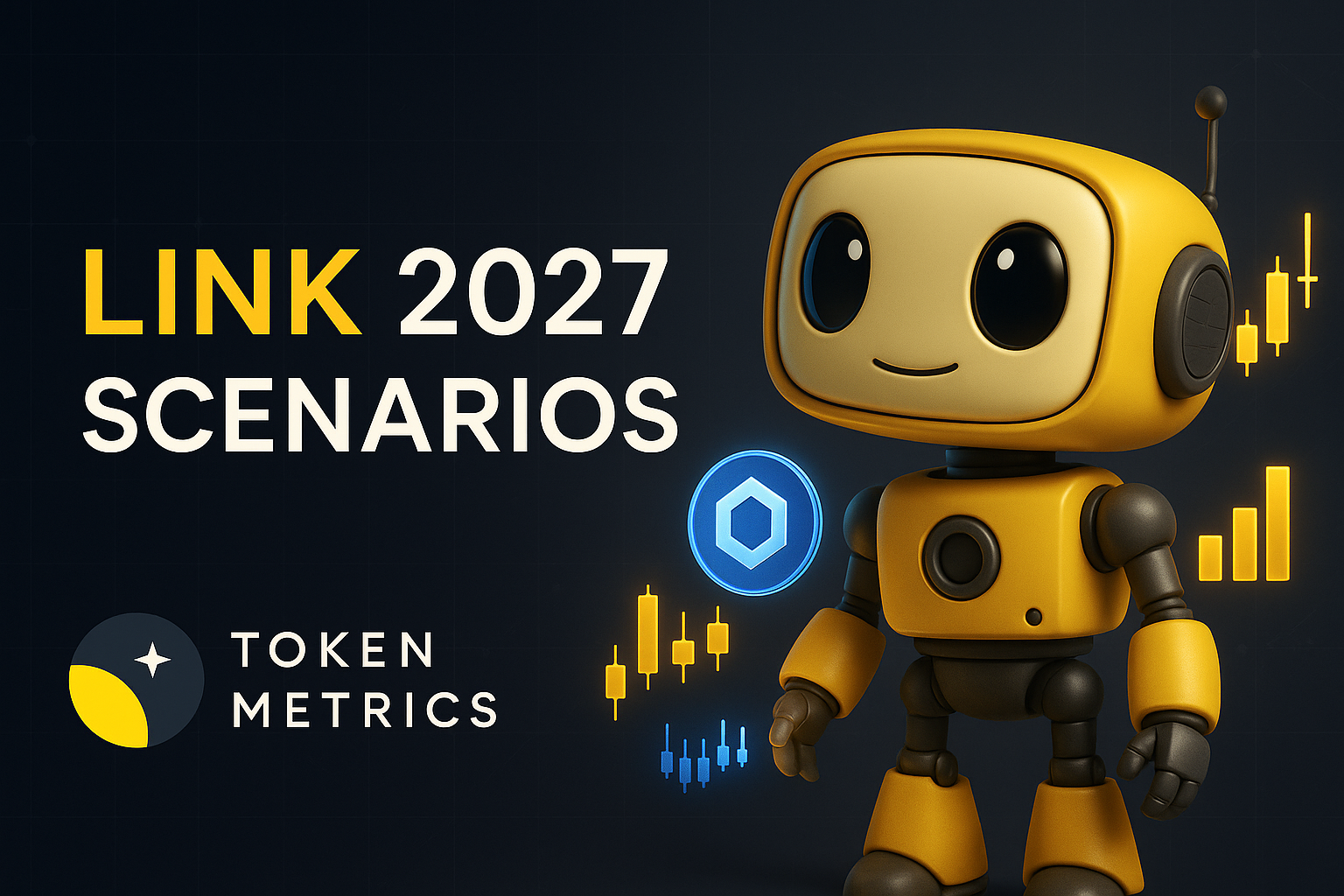Top Crypto Trading Platforms in 2025







%201.svg)
%201.svg)
Big news: We’re cranking up the heat on AI-driven crypto analytics with the launch of the Token Metrics API and our official SDK (Software Development Kit). This isn’t just an upgrade – it's a quantum leap, giving traders, hedge funds, developers, and institutions direct access to cutting-edge market intelligence, trading signals, and predictive analytics.
Crypto markets move fast, and having real-time, AI-powered insights can be the difference between catching the next big trend or getting left behind. Until now, traders and quants have been wrestling with scattered data, delayed reporting, and a lack of truly predictive analytics. Not anymore.
The Token Metrics API delivers 32+ high-performance endpoints packed with powerful AI-driven insights right into your lap, including:
Getting started with the Token Metrics API is simple:
At Token Metrics, we believe data should be decentralized, predictive, and actionable.
The Token Metrics API & SDK bring next-gen AI-powered crypto intelligence to anyone looking to trade smarter, build better, and stay ahead of the curve. With our official SDK, developers can plug these insights into their own trading bots, dashboards, and research tools – no need to reinvent the wheel.
%201.svg)
%201.svg)
Infrastructure protocols become more valuable as the crypto ecosystem scales and relies on robust middleware. Chainlink provides critical oracle infrastructure where proven utility and deep integrations drive long-term value over retail speculation. Increasing institutional adoption raises demand for professional-grade data delivery and security.
Token Metrics projections for LINK below span multiple total market cap scenarios from conservative to aggressive. Each tier assumes different levels of infrastructure demand as crypto evolves from speculative markets to institutional-grade systems. These bands frame LINK's potential outcomes into 2027.

Disclosure
Educational purposes only, not financial advice. Crypto is volatile, do your own research and manage risk.
How to read it: Each band blends cycle analogues and market-cap share math with TA guardrails. Base assumes steady adoption and neutral or positive macro. Moon layers in a liquidity boom. Bear assumes muted flows and tighter liquidity.
TM Agent baseline: Token Metrics lead metric for Chainlink, cashtag $LINK, is a TM Grade of 23.31%, which translates to a Sell, and the trading signal is bearish, indicating short-term downward momentum. This means Token Metrics currently does not endorse $LINK as a long-term buy at current conditions.
Live details: Chainlink Token Details
Affiliate Disclosure: We may earn a commission from qualifying purchases made via this link, at no extra cost to you.
Token Metrics scenarios span four market cap tiers, each representing different levels of crypto market maturity and liquidity:
8T: At an 8 trillion dollar total crypto market cap, LINK projects to $26.10 in bear conditions, $30.65 in the base case, and $35.20 in bullish scenarios.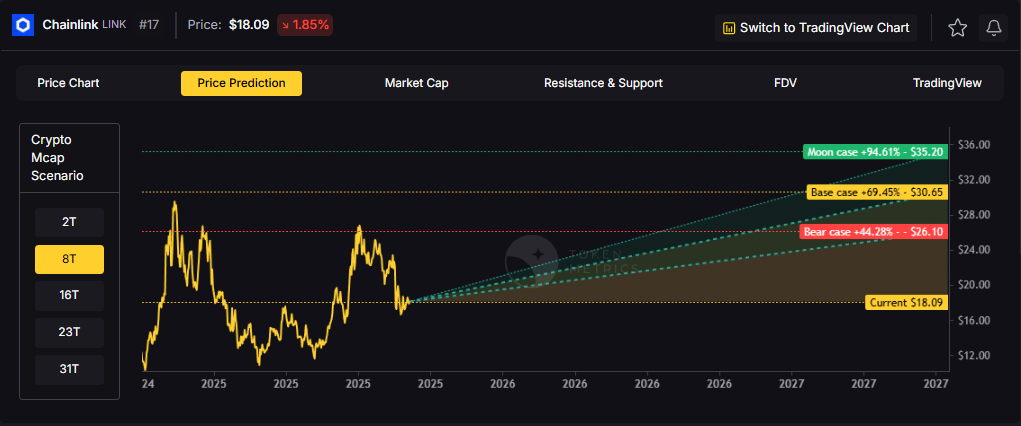
16T: Doubling the market to 16 trillion expands the range to $42.64 (bear), $56.29 (base), and $69.95 (moon).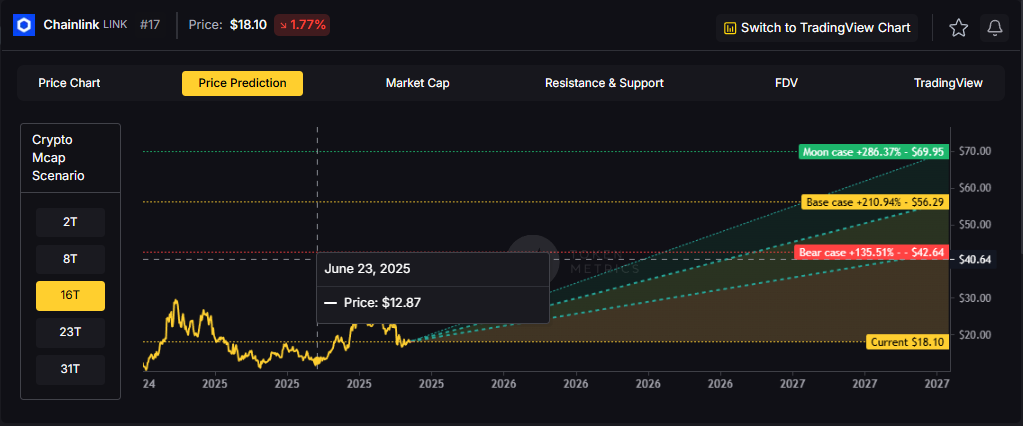
23T: At 23 trillion, the scenarios show $59.18, $81.94, and $104.70 respectively.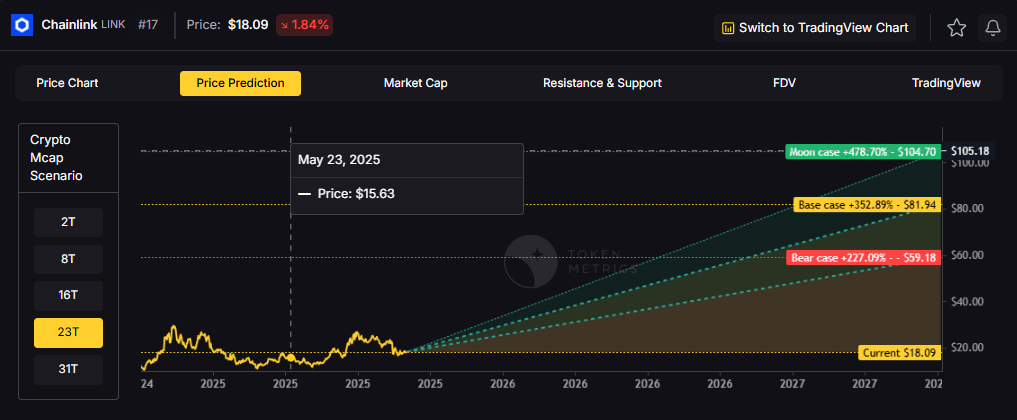
31T: In the maximum liquidity scenario of 31 trillion, LINK could reach $75.71 (bear), $107.58 (base), or $139.44 (moon).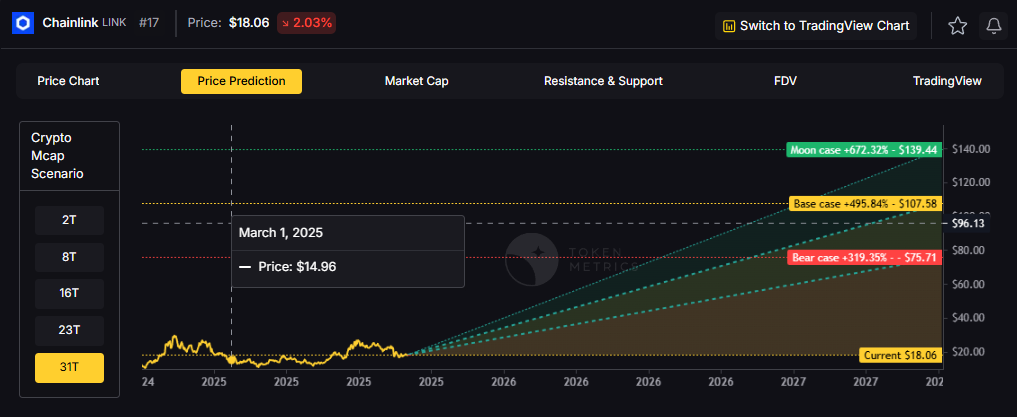
Chainlink represents one opportunity among hundreds in crypto markets. Token Metrics Indices bundle LINK with top one hundred assets for systematic exposure to the strongest projects. Single tokens face idiosyncratic risks that diversified baskets mitigate.
Historical index performance demonstrates the value of systematic diversification versus concentrated positions.
Chainlink is a decentralized oracle network that connects smart contracts to real-world data and systems. It enables secure retrieval and verification of off-chain information, supports computation, and integrates across multiple blockchains. As adoption grows, Chainlink serves as critical infrastructure for reliable data feeds and automation.
The LINK token is used to pay node operators and secure the network’s services. Common use cases include DeFi price feeds, insurance, and enterprise integrations, with CCIP extending cross-chain messaging and token transfers.
Vision: Chainlink aims to create a decentralized, secure, and reliable network for connecting smart contracts with real-world data and systems. Its vision is to become the standard for how blockchains interact with external environments, enabling trust-minimized automation across industries.
Problem: Smart contracts cannot natively access data outside their blockchain, limiting their functionality. Relying on centralized oracles introduces single points of failure and undermines the security and decentralization of blockchain applications. This creates a critical need for a trustless, tamper-proof way to bring real-world information onto blockchains.
Solution: Chainlink solves this by operating a decentralized network of node operators that fetch, aggregate, and deliver data from off-chain sources to smart contracts. It uses cryptographic proofs, reputation systems, and economic incentives to ensure data integrity. The network supports various data types and computation tasks, allowing developers to build complex, data-driven decentralized applications.
Market Analysis: Chainlink is a market leader in the oracle space and a key infrastructure component in the broader blockchain ecosystem, particularly within Ethereum and other smart contract platforms. It faces competition from emerging oracle networks like Band Protocol and API3, but maintains a strong first-mover advantage and widespread integration across DeFi, NFTs, and enterprise blockchain solutions. Adoption is driven by developer activity, partnerships with major blockchain projects, and demand for secure data feeds. Key risks include technological shifts, regulatory scrutiny on data providers, and execution challenges in scaling decentralized oracle networks. As smart contract usage grows, so does the potential for oracle services, positioning Chainlink at the center of a critical niche, though its success depends on maintaining security and decentralization over time.
Fundamental Grade: 74.58% (Community 81%, Tokenomics 100%, Exchange 100%, VC —, DeFi Scanner 17%).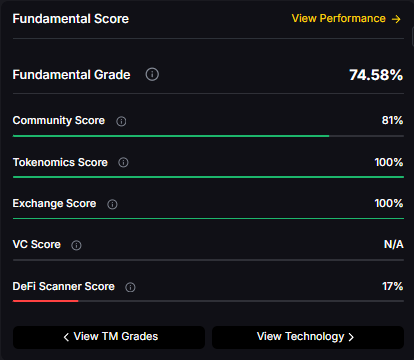
Technology Grade: 88.50% (Activity 81%, Repository 72%, Collaboration 100%, Security 86%, DeFi Scanner 17%).
Can LINK reach $100?
Yes. Based on the scenarios, LINK could reach $100+ in the 23T moon case. The 23T tier projects $104.70 in the moon case. Not financial advice.
What price could LINK reach in the moon case?
Moon case projections range from $35.20 at 8T to $139.44 at 31T. These scenarios assume maximum liquidity expansion and strong Chainlink adoption. Not financial advice.
Should I buy LINK now or wait?
Timing depends on risk tolerance and macro outlook. Current price of $18.09 sits below the 8T bear case in the scenarios. Dollar-cost averaging may reduce timing risk. Not financial advice.
Track live grades and signals: Token Details
Want exposure? Buy LINK on MEXC
Disclosure
Educational purposes only, not financial advice. Crypto is volatile, do your own research and manage risk.
Discover the full potential of your crypto research and portfolio management with Token Metrics. Our ratings combine AI-driven analytics, on-chain data, and decades of investing expertise—giving you the edge to navigate fast-changing markets. Try our platform to access scenario-based price targets, token grades, indices, and more for institutional and individual investors. Token Metrics is your research partner through every crypto market cycle.
%201.svg)
%201.svg)
The crypto market is tilting bullish into 2026 as liquidity, infrastructure, and participation improve across the board. Clearer rules and standards are reshaping the classic four-year cycle, flows can arrive earlier, and strength can persist longer than in prior expansions.
Institutional access is widening through ETFs and custody, while L2 scaling and real-world integrations help sustain on‑chain activity. This healthier backdrop frames our scenario work for HYPE. The ranges below reflect different total crypto market sizes and the share Hyperliquid could capture under each regime.
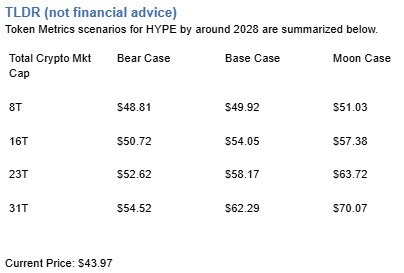
Disclosure
Educational purposes only, not financial advice. Crypto is volatile, do your own research and manage risk.
How to read it: Each band blends cycle analogues and market-cap share math with TA guardrails. Base assumes steady adoption and neutral or positive macro. Moon layers in a liquidity boom. Bear assumes muted flows and tighter liquidity.
TM Agent baseline: Token Metrics TM Grade is 73.9%, a Buy, and the trading signal is bearish, indicating short-term downward momentum. This means Token Metrics judges HYPE as fundamentally attractive over the long term, while near-term momentum is negative and may limit rallies.
Live details: Hyperliquid Token Details
Affiliate Disclosure: We may earn a commission from qualifying purchases made via this link, at no extra cost to you.
Scenario Analysis
Token Metrics scenarios span four market cap tiers, each representing different levels of crypto market maturity and liquidity:
8T: At an 8 trillion dollar total crypto market cap, HYPE projects to $48.81 in bear conditions, $49.92 in the base case, and $51.03 in bullish scenarios.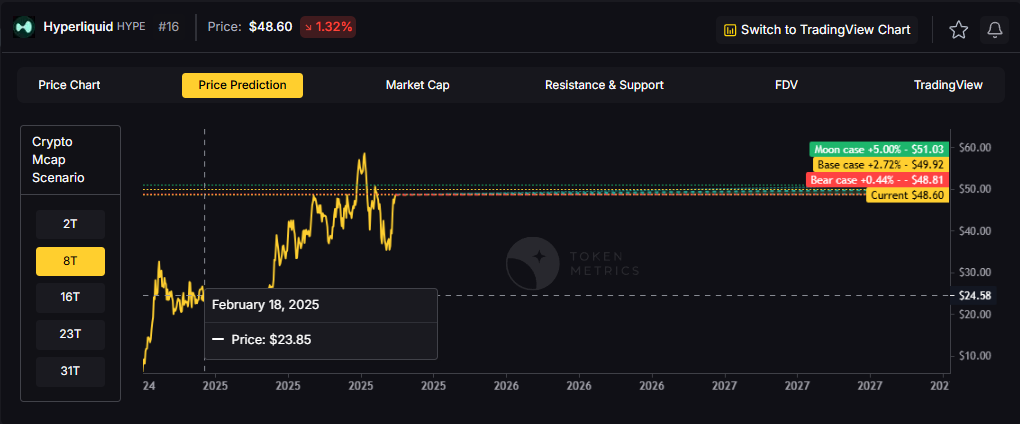
16T: Doubling the market to 16 trillion expands the range to $50.72 (bear), $54.05 (base), and $57.38 (moon).
23T: At 23 trillion, the scenarios show $52.62, $58.17, and $63.72 respectively.
31T: In the maximum liquidity scenario of 31 trillion, HYPE could reach $54.52 (bear), $62.29 (base), or $70.07 (moon).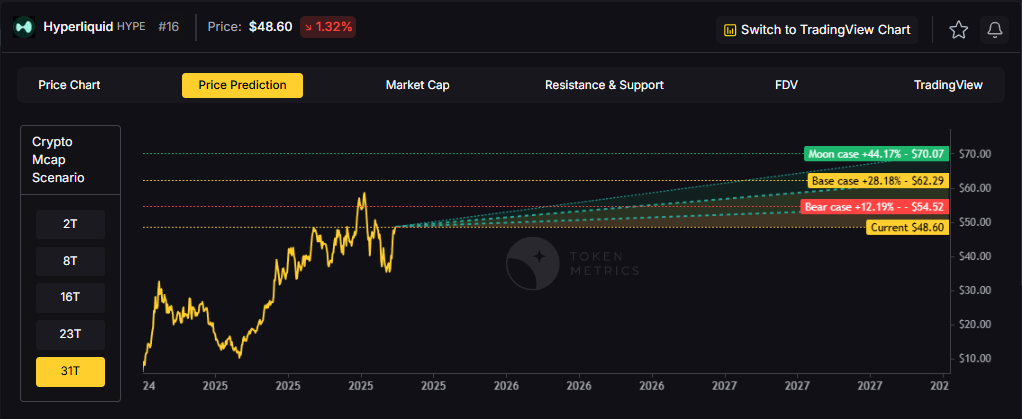
Each tier assumes progressively stronger market conditions, with the base case reflecting steady growth and the moon case requiring sustained bull market dynamics.
Diversification matters. HYPE is compelling, yet concentrated bets can be volatile. Token Metrics Indices hold HYPE alongside the top one hundred tokens for broad exposure to leaders and emerging winners.
Our backtests indicate that owning the full market with diversified indices has historically outperformed both the total market and Bitcoin in many regimes due to diversification and rotation.
Hyperliquid is a decentralized exchange focused on perpetual futures with a high-performance order book architecture. The project emphasizes low-latency trading, risk controls, and capital efficiency aimed at professional and retail derivatives traders. Its token, HYPE, is used for ecosystem incentives and governance-related utilities.
Can HYPE reach $60?
Yes, the 23T and 31T tiers imply ranges above $60 in the Base and Moon bands, though outcomes depend on liquidity and adoption. Not financial advice.
Is HYPE a good long-term investment?
Outcome depends on adoption, liquidity regime, competition, and supply dynamics. Diversify and size positions responsibly.
Disclosure
Educational purposes only, not financial advice. Crypto is volatile, do your own research and manage risk.
Token Metrics delivers AI-based crypto ratings, scenario projections, and portfolio tools so you can make smarter decisions. Discover real-time analytics on Token Metrics.
%201.svg)
%201.svg)
The Layer 1 competitive landscape is consolidating as markets recognize that specialization matters more than being a generic "Ethereum killer." Cardano positions itself in this multi-chain world with specific technical and ecosystem advantages. Infrastructure maturity around custody, bridges, and developer tools makes alternative L1s more accessible heading into 2026.
The scenario projections below map different market share outcomes for ADA across varying total crypto market sizes. Base cases assume Cardano maintains current ecosystem momentum, while moon scenarios factor in accelerated adoption and bear cases reflect increased competitive pressure.

Disclosure
Educational purposes only, not financial advice. Crypto is volatile, do your own research and manage risk.
How to read it: Each band blends cycle analogues and market-cap share math with TA guardrails. Base assumes steady adoption and neutral or positive macro. Moon layers in a liquidity boom. Bear assumes muted flows and tighter liquidity.
TM Agent baseline: Token Metrics lead metric for Cardano, cashtag $ADA, is a TM Grade of 29.72%, which translates to a Sell, and the trading signal is bearish, indicating short-term downward momentum. This combination means Token Metrics does not currently endorse $ADA as a long-term buy at current levels. A brief market context: Bitcoin's direction remains the dominant macro driver for smart contract platforms, so sustained upside for $ADA would require a broader crypto risk-on regime and improving fundamentals or developer activity for Cardano.
Live details: Cardano Token Details
Affiliate Disclosure: We may earn a commission from qualifying purchases made via this link, at no extra cost to you.
Token Metrics scenarios span four market cap tiers, each representing different levels of crypto market maturity and liquidity:




Each tier assumes progressively stronger market conditions, with the base case reflecting steady growth and the moon case requiring sustained bull market dynamics.
Cardano represents one opportunity among hundreds in crypto markets. Token Metrics Indices bundle ADA with top one hundred assets for systematic exposure to the strongest projects. Single tokens face idiosyncratic risks that diversified baskets mitigate.
Historical index performance demonstrates the value of systematic diversification versus concentrated positions.
Cardano is a blockchain platform designed to support secure, scalable, and sustainable decentralized applications and smart contracts. It is known for its research-driven development approach, emphasizing peer-reviewed academic research and formal verification methods to ensure reliability and security. As a proof-of-stake Layer 1 blockchain, Cardano aims to offer energy efficiency and long-term scalability, positioning itself as a competitor to platforms like Ethereum. Its native token, ADA, is used for transactions, staking, and governance. Adoption is driven by technological rigor and ecosystem growth, though progress has been criticized for being slow compared to more agile competitors. Risks include execution delays, competition, and market volatility.
Cardano’s vision is to create a decentralized platform that enables sustainable and inclusive economic systems through advanced cryptography and scientific methodology. It aims to bridge gaps between traditional financial systems and blockchain technology, promoting accessibility and security for users globally.
Token Metrics AI provides comprehensive context on Cardano's positioning and challenges.


Can ADA reach $4?
Based on the scenarios, ADA could reach $4 in the 31T moon case. The 31T tier projects $4.27 in the moon case. Not financial advice.
Can ADA 10x from current levels?
At current price of $0.65, a 10x would reach $6.50. This falls within none of the provided scenarios, which top out at $4.27 in the 31T moon case. Bear in mind that 10x returns require substantial market cap expansion. Not financial advice.
What price could ADA reach in the moon case?
Moon case projections range from $1.16 at 8T to $4.27 at 31T. These scenarios assume maximum liquidity expansion and strong Cardano adoption. Not financial advice.
Disclosure
Educational purposes only, not financial advice. Crypto is volatile, do your own research and manage risk.

%201.svg)
%201.svg)
Cryptocurrency trading can be highly rewarding, but it’s also one of the riskiest financial activities you can engage in. Prices can swing wildly within minutes, markets are largely unregulated, and scams remain rampant. Whether you’re a beginner investor or a seasoned trader, understanding these risks is critical for protecting your capital and making informed decisions.
In this guide, we’ll break down the biggest risks in crypto trading, how to recognize them, and how Token Metrics can help you minimize those risks using AI-driven insights.
The crypto market is famous for its rapid price fluctuations. Unlike traditional stocks, which typically move in small percentages daily, cryptocurrencies can experience 10–50% swings in a single day.
How Token Metrics Helps:
Token Metrics provides AI-powered trading signals and market trend analysis to help you avoid trading blindly. Our Trader Grades let you know when an asset is trending bullish or bearish, giving you data-driven entry and exit points.
Unlike traditional finance, cryptocurrency operates in a largely unregulated space. This creates both opportunities and risks.
How Token Metrics Helps:
We track regulatory trends and narratives using AI-driven sentiment analysis, alerting you to shifts that could impact your holdings.
Crypto traders often store their assets on exchanges or hot wallets—prime targets for hackers.
How Token Metrics Helps:
Token Metrics evaluates crypto projects with AI-based risk scoring, helping you avoid tokens and platforms with poor security practices or suspicious activity.
From rug pulls to fake ICOs and Ponzi schemes, crypto has become a hotbed for scams targeting inexperienced traders.
How Token Metrics Helps:
Our Moonshot Finder doesn’t just find hidden gem tokens—it uses AI-driven vetting to filter out high-risk projects, helping you spot potential scams before you invest.
The fear of missing out (FOMO) and panic selling are two of the biggest psychological pitfalls in crypto trading.
How Token Metrics Helps:
By offering objective, AI-driven market insights, Token Metrics removes the emotional bias from trading. Our data-backed signals tell you when to hold, sell, or accumulate—reducing emotionally driven mistakes.
Some cryptocurrencies—especially low-cap altcoins—have low liquidity, making it difficult to buy or sell without significantly impacting the price.
How Token Metrics Helps:
Our platform tracks liquidity metrics for thousands of tokens, ensuring you know the trading conditions before entering or exiting a position.
While leverage trading can amplify profits, it can also wipe out your portfolio quickly.
How Token Metrics Helps:
Token Metrics identifies high-probability trades using AI-based technical analysis, reducing the guesswork in leveraged trading.
Crypto prices are often driven by hype, social media trends, and narratives, which can be unpredictable and short-lived.
How Token Metrics Helps:
Our AI detects emerging narratives early—whether it’s AI tokens, DeFi, or RWA projects—so you can position yourself before the hype cycle peaks.
Here are some best practices for reducing crypto trading risks:
Token Metrics is more than a research platform—it’s your AI-powered trading assistant. Here’s why traders trust it:

Whether you’re a beginner looking to avoid common pitfalls or an advanced trader seeking data-driven edge, Token Metrics helps you trade smarter and safer.
So, what are the biggest risks in crypto trading? From extreme volatility and scams to emotional decision-making and security threats, the dangers are real. But with the right strategies and tools, you can navigate the market with confidence.
By using Token Metrics’ AI-powered insights, you can reduce emotional bias, avoid high-risk tokens, and make smarter, data-driven trades—turning crypto’s volatility from a threat into an opportunity.

%201.svg)
%201.svg)
Cryptocurrency markets are known for their volatility and unpredictability, making price analysis an essential skill for anyone looking to trade or invest successfully. Whether you’re a beginner trying to understand Bitcoin’s price swings or an advanced trader looking for early opportunities in altcoins, knowing how to analyze crypto prices can make or break your portfolio.
In this guide, we’ll break down the main methods for analyzing cryptocurrency prices, explain the key tools you need, and show you why Token Metrics is the best AI-powered platform for making smarter, data-driven trading decisions.

Unlike traditional stocks, cryptocurrencies are influenced by a unique combination of factors:
With prices moving 10–20% in a single day, traders and investors need a clear strategy to separate noise from actionable insights. That’s where price analysis comes in.
To effectively analyze crypto prices, you need to combine three primary approaches:
Technical analysis focuses on historical price data, patterns, and indicators to forecast future price movements.
Key Tools & Indicators:
How Token Metrics Helps:
Token Metrics enhances traditional TA by incorporating AI-driven market signals. Our system analyzes 80+ technical indicators across thousands of assets to deliver real-time bullish or bearish signals, helping traders know when to enter or exit positions.
Fundamental analysis evaluates the intrinsic value of a cryptocurrency by examining factors beyond price.
Key Metrics:
How Token Metrics Helps:
Token Metrics uses Investor Grades to assess cryptocurrencies based on their long-term growth potential. This AI-powered scoring system combines project fundamentals, tokenomics, and on-chain data to help investors focus on projects with real staying power.
The crypto market is heavily influenced by emotions, hype, and narratives. Sentiment analysis involves monitoring social media trends, news coverage, and community discussions to gauge overall market mood.
Key Sentiment Indicators:
How Token Metrics Helps:
Our platform goes beyond surface-level sentiment analysis by using AI to detect narrative-driven opportunities before they hit the mainstream. This is especially useful for finding Moonshot tokens—low-cap projects with high potential for explosive growth.
The most successful traders don’t rely on just one method—they combine technical, fundamental, and sentiment analysis to form a complete market picture.
Here’s how you can use this in practice:
With thousands of cryptocurrencies in the market, manual analysis is nearly impossible. Token Metrics simplifies and supercharges your analysis using AI.
Here’s what makes it the best platform for crypto price analysis:
Get real-time bullish and bearish signals based on 80+ data points per asset—helping you make quick, informed decisions.

Our scoring system helps you find short-term trading opportunities (Trader Grade) and long-term investment picks (Investor Grade).
Discover low-cap hidden gems before they gain mainstream attention—ideal for high-risk, high-reward plays.

Don’t want to analyze every token? Token Metrics offers AI-managed portfolios that automatically rebalance based on market conditions.

So, how do you analyze cryptocurrency prices? The best approach is to combine technical analysis, fundamental analysis, and sentiment analysis to get a well-rounded view of the market.
But doing this manually is overwhelming—which is why Token Metrics is the best AI-powered solution for crypto analysis. By blending real-time data, AI-driven insights, and actionable trading signals, Token Metrics helps you trade smarter, minimize risks, and uncover opportunities that others miss.
Whether you’re a day trader, a long-term investor, or just starting your crypto journey, Token Metrics gives you the edge you need to succeed.

%201.svg)
%201.svg)
Cryptocurrency trading has evolved into one of the most dynamic ways to generate profits in financial markets. But before jumping in, it’s crucial to understand the different types of crypto trading strategies. Whether you’re a beginner or an experienced trader, knowing these styles will help you choose an approach that matches your risk tolerance, time commitment, and profit goals.
In this guide, we’ll break down the main types of crypto trading, who they’re best for, and how platforms like Token Metrics can help you succeed with AI-powered insights.
Crypto is a 24/7, high-volatility market where fortunes can be made—or lost—quickly. Picking the right trading style helps you:

There are several trading strategies in crypto, but these five dominate the space:
Day trading involves buying and selling crypto within the same day to profit from short-term price movements.
Swing trading focuses on holding positions for several days or weeks to capture larger price swings.
Scalping involves making dozens (or even hundreds) of trades daily to profit from tiny price changes.
Position trading, often called HODLing, is a long-term investment strategy. Traders buy and hold assets for months or years, ignoring short-term fluctuations.
Arbitrage trading exploits price differences for the same crypto on different exchanges.
When deciding which type of trading suits you, consider:
No matter your trading strategy, Token Metrics provides the tools to help you succeed:
Whether you’re a day trader chasing fast gains or a long-term HODLer, Token Metrics simplifies research and helps you execute strategies with confidence.
So, what are the main types of crypto trading?
Each type of trading has its pros and cons, but with AI-powered tools from Token Metrics, you can make smarter decisions, reduce guesswork, and trade confidently—regardless of your preferred style.

%201.svg)
%201.svg)
Cryptocurrency trading has revolutionized how people invest, allowing anyone with an internet connection to access global markets 24/7. But one of the most common questions beginners ask is: "How much money do I need to start trading crypto?"
The answer depends on your goals, risk tolerance, and the strategies you intend to use. In this article, we’ll explore how much you really need to get started, break down different trading approaches, and explain how platforms like Token Metrics can help you trade smarter with AI-driven insights—even with a small budget.
Before determining how much money you need, it’s essential to understand what crypto trading involves. Cryptocurrency trading is the process of buying and selling digital assets like Bitcoin, Ethereum, and altcoins to profit from price movements. Unlike traditional stock markets, crypto markets:
However, the volatile nature of crypto means your starting amount must align with your risk management plan.
There’s no single amount required to start trading crypto—it largely depends on your trading style, goals, and platform. Here’s a breakdown:
Most exchanges like Binance, Coinbase, and Kraken allow users to start trading with as little as $10–$50. This is a great entry point for beginners who want to learn the ropes without risking too much.
Many beginner traders find $250–$500 to be a sweet spot. This amount allows for diversification—spreading funds across multiple tokens—and gives you enough margin to experiment with different strategies.
This amount balances risk and opportunity, helping you learn without overexposing yourself.
If your goal is to actively trade (day trading, swing trading, or building a diversified portfolio), starting with $1,000+ gives you more flexibility.
When deciding how much to invest, consider these factors:
Crypto is volatile—price swings of 10–20% in a single day are common. Only invest what you can afford to lose.
Are you aiming for quick profits (day trading), medium-term growth (swing trading), or long-term wealth (HODLing)? Your goals will dictate your starting amount.
Scalping or day trading requires more capital for frequent trades, while long-term investing can start with smaller amounts.
Trading fees, withdrawal fees, and network fees can impact your profits. Some exchanges have minimum trade sizes, so starting with too little might not be practical.
Starting with a small amount doesn’t mean you can’t succeed. With AI-driven research and trading tools, platforms like Token Metrics level the playing field for beginners and experienced traders alike.

Here’s how Token Metrics can help:
Token Metrics provides real-time bullish and bearish signals based on 80+ data points. This helps you make smarter entry and exit decisions—crucial when trading with limited funds.

Our Trader and Investor Grades score tokens based on short-term and long-term potential, helping you focus on assets with the best risk-reward profile.
Want to turn a small investment into something bigger? Token Metrics’ Moonshot Finder identifies high-potential low-cap altcoins before they pump, giving you an edge.

Don’t know where to start? Token Metrics offers AI-driven crypto indices, automatically managing a diversified portfolio based on current market conditions.
Whether you’re starting with $0 or $166.7 per month, Token Metrics offers free and paid plans to match your needs.
ake Money Starting Small?Yes, you can—but it requires patience, strategy, and the right tools. Many traders have grown $100–$500 portfolios into thousands by leveraging long-term investments in quality projects and AI-guided trading signals.
So, how much money do you need to start crypto trading?
The truth is—you can start with as little as $10, but for a more meaningful experience and potential growth, $250–$1,000 is a practical starting range.
The key isn’t just the amount—it’s how you trade. Using AI-driven insights from Token Metrics, you can make smarter decisions, find hidden gems, and navigate crypto’s volatility like a pro.
Whether you’re starting small or diving in with a bigger budget, Token Metrics helps you trade confidently and build a strategy tailored to your goals.

%201.svg)
%201.svg)
In 2025, crypto has matured into a multi‑trillion‑dollar market, attracting everyone from day traders to long‑term institutional investors. But not all approaches to crypto are the same.
If you’re new to digital assets, you might wonder: “What’s the difference between trading and investing in crypto?” Understanding the distinction will help you choose the strategy that matches your goals, risk tolerance, and time commitment.
This guide breaks down trading vs. investing in crypto — explaining their key differences, benefits, risks, and how Token Metrics empowers you to succeed at either.
Crypto trading is the short‑term buying and selling of cryptocurrencies to profit from price fluctuations.
Timeframe:
Objective:
Approach:
Common Trading Styles:
Pro Tip:
Traders rely heavily on real‑time data and AI‑driven insights to react fast. Tools like Token Metrics provide trading signals, narrative detection, and technical ratings for hundreds of tokens.
Crypto investing is the long‑term holding of digital assets based on their growth potential.
Timeframe:
Objective:
Approach:
Common Investing Strategies:
Pro Tip:
Investors benefit from portfolio optimization tools like Token Metrics, which helps identify high‑potential projects and maintain balanced allocations.

Choose Trading If:
Choose Investing If:
Or Do Both:
Many crypto enthusiasts combine the two — holding long‑term assets like Bitcoin and Ethereum while trading smaller portions for short‑term gains.
Whether you’re trading or investing, Token Metrics is an essential AI‑powered platform for making smarter decisions.

For Traders:
For Investors:
In short: Token Metrics helps traders react faster and investors plan smarter.
Drawbacks:
Drawbacks:
Imagine you allocate:
How Token Metrics Helps:

The difference between trading and investing in crypto comes down to timeframes, goals, and risk tolerance.
No matter which approach you choose, Token Metrics — the leading AI crypto analysis, research, and trading platform — gives you the tools to succeed.
By combining AI‑powered insights, narrative detection, and portfolio optimization, Token Metrics helps both traders and investors make smarter, data‑driven decisions in 2025.

%201.svg)
%201.svg)
In 2025, cryptocurrency trading is more accessible than ever, with hundreds of exchanges competing for your attention. But choosing the right exchange can make the difference between a smooth, profitable trading experience and one full of unnecessary risks, high fees, or limited features.
If you’re asking “Which cryptocurrency exchange should I use?”, this guide will help you compare the top platforms and explain how Token Metrics — the leading AI‑powered crypto analysis, research, and trading platform — can help you trade smarter no matter which exchange you choose.
Before selecting an exchange, it’s important to understand your options:
1. Centralized Exchanges (CEXs):
2. Decentralized Exchanges (DEXs):
3. Hybrid Exchanges:
Pro Tip: Beginners usually start with a trusted CEX, then gradually explore DEXs for more control and advanced opportunities.
Here are some of the leading exchanges to consider:
When deciding which platform to use, consider:
Choosing an exchange is just the first step. To maximize profits, you need data‑driven insights, trend detection, and portfolio strategies — that’s where Token Metrics comes in.
No matter which exchange you choose, Token Metrics empowers you to trade smarter with AI‑powered crypto analysis, research, and trading tools.

Here’s how:
In short: Token Metrics isn’t an exchange — it’s your personal AI crypto research assistant.
Let’s say you trade on Binance:
This combination lets you trade like a pro without guesswork.
No matter which exchange you choose:
So, which cryptocurrency exchange should you use?
But remember — the exchange is only part of the equation.
To trade profitably in 2025, pair your chosen exchange with Token Metrics — the ultimate AI‑powered crypto research, analysis, and trading platform.
Whether you’re buying your first Bitcoin or trading advanced altcoins, Token Metrics helps you cut through noise, detect trends early, and make smarter, data‑driven decisions.

%201.svg)
%201.svg)
Cryptocurrency trading has grown from a niche activity into a global financial revolution, with billions traded daily across thousands of digital assets. In 2025, crypto trading isn’t just about buying Bitcoin—it’s a sophisticated market with opportunities in altcoins, AI tokens, DeFi protocols, and more.
But getting started can be overwhelming. If you’re asking, “How do I start trading cryptocurrency?”, this guide will walk you through everything—from setting up accounts to using AI‑powered tools like Token Metrics to trade smarter.

Before you trade, you need to understand what you’re trading.
Pro Tip: Use Token Metrics’ coin ratings to evaluate projects based on fundamentals, technicals, and on‑chain data.
To start trading, you’ll need an account on a crypto exchange.
Centralized Exchanges (CEXs):
Decentralized Exchanges (DEXs):
Pro Tip: Start with a reputable CEX, then gradually explore DEXs as you gain experience.
A wallet stores your crypto securely.

Rule of Thumb:
To trade, you’ll need to deposit money:
Pro Tip: Always use verified exchanges to avoid scams.
Crypto trading isn’t just buying and holding. Common strategies include:
Pro Tip: Start with spot trading before exploring advanced strategies.
Trading requires informed decisions, not guesses.
Types of Analysis:
Token Metrics simplifies this with AI‑powered coin ratings, narrative detection, and real‑time analytics.
Crypto is volatile. Start with a small allocation (1–5% of your portfolio) while you learn the ropes.
Golden Rule:
Never invest money you can’t afford to lose.
Risk management is critical for long‑term success.
Pro Tip: Token Metrics’ portfolio optimizer can help balance risk and return.
Don’t trade emotionally. Create a plan that includes:
AI‑powered tools like Token Metrics can automate alerts for your planned price levels.
The crypto market moves fast. Keep learning:
Trading doesn’t have to be guesswork. AI platforms like Token Metrics help by:
With AI, even beginners can trade like seasoned professionals.
Starting your crypto trading journey in 2025 is easier than ever — but success requires planning, discipline, and the right tools.
By choosing a reliable exchange, using secure wallets, starting small, and leveraging AI‑driven insights from Token Metrics, you can confidently navigate the crypto market and turn trading into a profitable venture.
In crypto, knowledge is power — and in 2025, AI‑powered knowledge is the ultimate advantage.

%201.svg)
%201.svg)
Cryptocurrency has always been volatile, but in 2025, the stakes are even higher. With billions flowing into AI‑driven tokens, real‑world asset (RWA) projects, DeFi protocols, and meme coins, the crypto market is more complex than ever.
While the potential for profits is enormous, so are the risks. Poor risk management can quickly turn promising portfolios into catastrophic losses. To succeed, you need structured strategies and AI‑powered insights from platforms like Token Metrics to help you make smarter, data‑driven decisions.
This guide explores the top strategies for managing crypto risk in 2025 — helping you stay profitable even in turbulent markets.
Don’t put all your crypto in one basket.
Diversification reduces your exposure to individual asset failures. In 2025, this means spreading across:
Pro Tip: Use Token Metrics’ portfolio optimization tool to create a diversified, AI‑recommended allocation aligned with your risk tolerance.
Position sizing determines how much of your portfolio is allocated to a single asset.
Key Rule: Never risk more than you’re willing to lose.
Crypto markets move fast — sometimes too fast for manual reactions.
Stop‑Loss Orders:
Take‑Profit Orders:
Why It Works: These orders enforce discipline, removing emotional decision‑making from the equation.

Stablecoins like USDC and USDT are essential for risk management.
Platforms like Token Metrics help track the optimal balance between stablecoins and risk assets for your portfolio.
Leverage amplifies both gains and losses.
AI‑powered insights from Token Metrics can help you assess volatility before taking leveraged positions.
DCA means investing a fixed amount regularly, regardless of price.
Pairing DCA with Token Metrics’ trend analysis ensures you’re accumulating assets with strong AI‑verified fundamentals.
Markets shift quickly. Rebalancing keeps your portfolio aligned with your goals.

Rebalance when:
Token Metrics’ portfolio tracker helps monitor your allocations and signals when adjustments are needed.
Narratives drive capital flows in crypto — AI tokens, DeFi 2.0, RWAs, and more are shaping 2025.
Why It Matters:
Token Metrics’ narrative detection tools help you spot these shifts early.
Even the best portfolio is useless if it’s hacked.

Crypto moves at lightning speed. Staying informed reduces surprises:


This portfolio balances security, growth, and liquidity.
Managing risk in crypto isn’t about avoiding volatility — it’s about embracing it intelligently.
By combining diversification, automated trading tools, hedging, and AI‑driven insights from Token Metrics, you can protect your capital and position yourself for consistent growth in 2025.
In crypto, survival is success — and with the right risk management strategies, you can turn survival into long‑term profitability.

%201.svg)
%201.svg)
Zero Knowledge Proofs (ZKPs) represent a groundbreaking cryptographic concept that enables one party to prove knowledge of specific information to another party without revealing the information itself. This technology is rapidly gaining traction within blockchain ecosystems and privacy-focused applications, offering novel approaches to verification and security without compromising sensitive data.
At its core, a Zero Knowledge Proof is a method by which a prover demonstrates to a verifier that a given statement is true, without revealing any additional information beyond the validity of the statement. Introduced in the 1980s, ZKPs rely on complex mathematical algorithms to ensure that knowledge can be proven without disclosure, preserving confidentiality.
The three essential properties that characterize zero knowledge proofs are:
There are several approaches to implementing ZKPs, each with its trade-offs and applications. Two of the most significant forms include zk-SNARKs and zk-STARKs.
Zero Knowledge Proofs have considerable implications for enhancing privacy and scalability in decentralized systems. Key applications include:
Despite their potential, Zero Knowledge Proofs face notable challenges that require careful consideration in practical deployment:
Advancements in Artificial Intelligence (AI) have begun to complement cryptographic research, including the exploration and utilization of Zero Knowledge Proofs. AI-driven analytical tools can assist researchers and developers by:
Platforms such as Token Metrics leverage AI-driven research to analyze emerging cryptographic technologies, including zero knowledge protocols, offering quantitative insights into technological developments and ecosystem dynamics.
When evaluating projects that incorporate zero knowledge proofs, consider the following research aspects to obtain an objective and thorough understanding:
Zero Knowledge Proofs are poised to become foundational in advancing privacy and scalability in decentralized systems. Future research continues to focus on:
Continued innovation in this domain is supported by cross-disciplinary collaborations, including cryptography, computer science, and AI research.
Zero Knowledge Proofs offer a powerful paradigm shift in cryptography, enabling privacy-preserving verification without information disclosure. Their adoption within blockchain and related fields supports the creation of secure, efficient, and private systems. Utilizing AI-powered platforms like Token Metrics can assist in analyzing and understanding the evolving landscape of zero knowledge proof technologies.
This article is for educational and informational purposes only. It does not constitute financial advice, investment recommendations, or endorsements. Readers should conduct their own research and consult professionals before making decisions related to cryptographic technologies or blockchain projects.


 Create Your Free Account
Create Your Free Account9450 SW Gemini Dr
PMB 59348
Beaverton, Oregon 97008-7105 US
.svg)




.png)
Token Metrics Media LLC is a regular publication of information, analysis, and commentary focused especially on blockchain technology and business, cryptocurrency, blockchain-based tokens, market trends, and trading strategies.
Token Metrics Media LLC does not provide individually tailored investment advice and does not take a subscriber’s or anyone’s personal circumstances into consideration when discussing investments; nor is Token Metrics Advisers LLC registered as an investment adviser or broker-dealer in any jurisdiction.
Information contained herein is not an offer or solicitation to buy, hold, or sell any security. The Token Metrics team has advised and invested in many blockchain companies. A complete list of their advisory roles and current holdings can be viewed here: https://tokenmetrics.com/disclosures.html/
Token Metrics Media LLC relies on information from various sources believed to be reliable, including clients and third parties, but cannot guarantee the accuracy and completeness of that information. Additionally, Token Metrics Media LLC does not provide tax advice, and investors are encouraged to consult with their personal tax advisors.
All investing involves risk, including the possible loss of money you invest, and past performance does not guarantee future performance. Ratings and price predictions are provided for informational and illustrative purposes, and may not reflect actual future performance.

